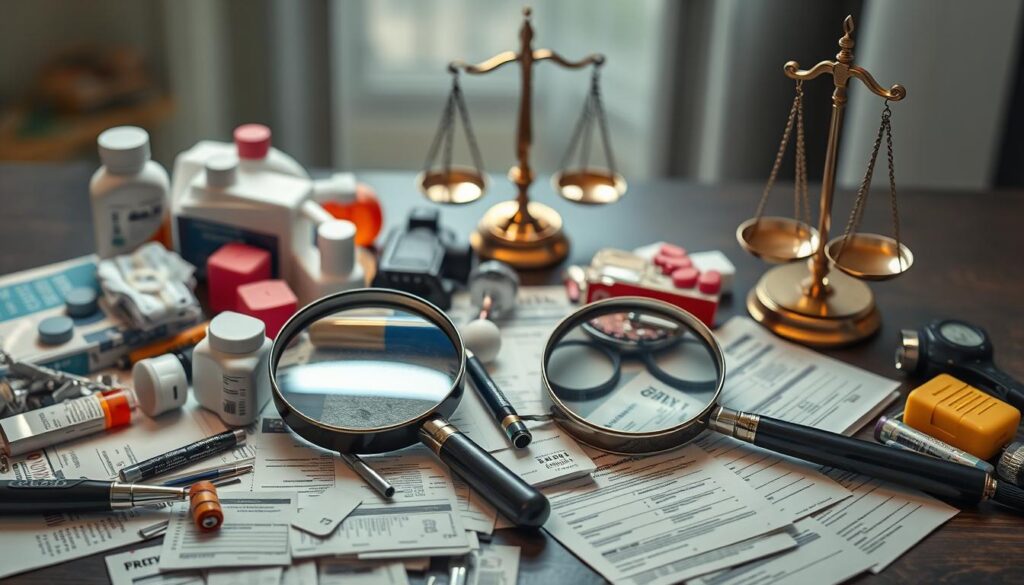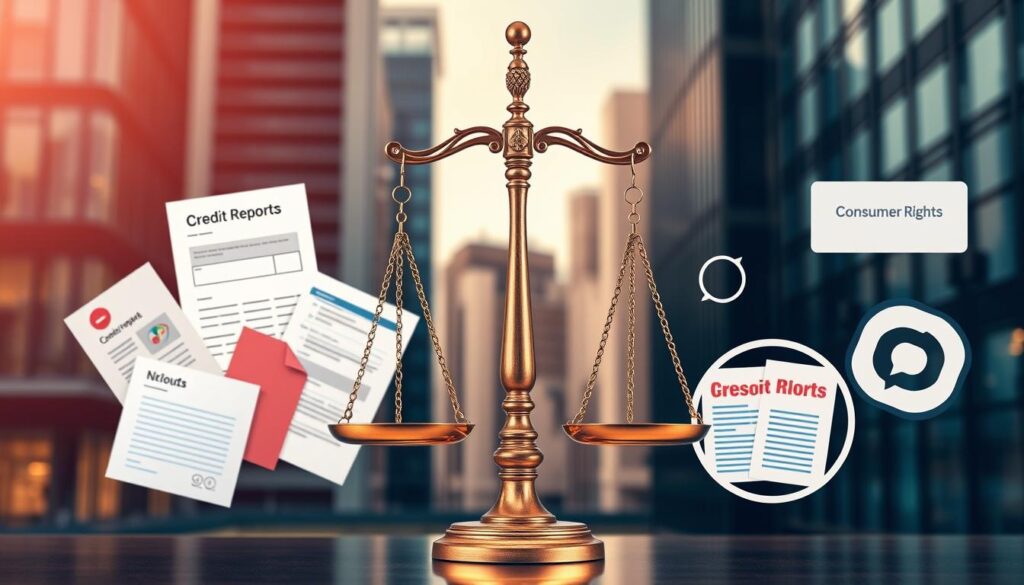Staying alert about your account information is crucial. Errors in financial records can lead to various problems. This section explores consumer disputes and how to handle them effectively.
We’ll cover common types of disputes and the resolution process. You’ll also learn strategies for solving account-related issues quickly and efficiently.
Key Takeaways
- Consumer disputes are crucial for maintaining the accuracy and security of your financial accounts.
- Understanding the different types of consumer disputes, such as billing errors and fraudulent charges, is essential for effective resolution.
- Familiarizing yourself with your rights under consumer protection laws can empower you to navigate the dispute process effectively.
- Employing effective communication strategies with financial institutions can significantly improve the chances of a favorable outcome.
- Leveraging consumer advocacy groups and resources can provide valuable assistance in resolving complex disputes.
Understanding Consumer Disputes
You have the right to dispute issues with your account information. Consumer disputes cover problems like billing errors, fraudulent charges, and account discrepancies. Knowing about these disputes can help you handle them better.
What Constitutes a Consumer Dispute?
A consumer dispute happens when you disagree with a service provider about a transaction. This can include problems with your account information. Let’s look at some common examples.
- Billing errors, such as incorrect charges or fees
- Fraudulent charges, including unauthorized or suspicious transactions
- Account discrepancies, such as inaccurate account balances or missing payments
Common Types of Consumer Disputes
Here are the most frequent consumer disputes you might face:
- Billing Errors: Incorrect charges, duplicate charges, or fees that were not part of the original agreement.
- Fraudulent Charges: Unauthorized transactions or charges that the consumer did not make or approve.
- Account Discrepancies: Inaccurate account balances, missing payments, or other issues with the consumer’s account information.
Knowing these types of disputes is key to solving them. It’s the first step in addressing and resolving issues effectively.

“Consumers have the right to dispute any issues or discrepancies related to their account information.”
| Type of Dispute | Description | Potential Resolution |
|---|---|---|
| Billing Errors | Incorrect charges, duplicate charges, or fees not part of the original agreement | Contact the service provider, provide evidence, and request a correction or refund |
| Fraudulent Charges | Unauthorized transactions or charges the consumer did not make or approve | Dispute the charges with the service provider, cancel the card, and report the fraud to relevant authorities |
| Account Discrepancies | Inaccurate account balances, missing payments, or other issues with account information | Review account statements, provide documentation, and work with the service provider to correct the discrepancy |
Consumer Disputes This Account Information
Dealing with account information disputes can be tricky. It’s vital to keep accurate records and protect your finances. Understanding the steps can help you resolve issues with credit cards, billing, or payments.
Credit Card Disputes
Credit card disputes often involve unauthorized charges or billing errors. You have the right to contest these issues. Contact your card issuer and provide details about the disputed charges.
Follow their specific dispute resolution procedures. This process helps ensure your account’s accuracy and protects your financial interests.
Billing Errors and Discrepancies
You can dispute inaccuracies like incorrect fees or charges in your account information. Gather all relevant documents to support your case. Reach out to your service provider or financial institution directly.
Follow their established dispute resolution protocols. This approach increases your chances of resolving billing discrepancies effectively.
Payment Disputes
Payment disputes may occur due to processing issues or misapplied payments. These can include problems with automatic payments or unexpected late fees. Work closely with your provider to understand the cause.
Collaborate to find a suitable solution. Clear communication is key in resolving payment-related concerns.
Address consumer disputes systematically and keep detailed records. Communicate effectively with all parties involved. This approach helps protect your financial interests and resolve account information issues successfully.

“Resolving consumer disputes requires patience, persistence, and a thorough understanding of your rights. With the right approach, you can effectively address account information issues and achieve a favorable outcome.”
Credit Card Disputes and Billing Errors
Credit card disputes and billing errors can cause headaches for consumers. These issues range from fraudulent charges to incorrect fees. Knowing how to handle these problems is crucial for protecting your finances.
Identifying Fraudulent Charges
Regularly check your monthly statements for suspicious charges. Fraudulent charges can be small purchases or large transactions. Report any unusual activity to your credit card company right away.
Disputing Incorrect Charges or Fees
Look for billing errors or incorrect charges on your statements. These may include wrong fees, duplicate charges, or items you didn’t receive. Follow the proper dispute process to resolve these credit card disputes.
You have the right to challenge any account discrepancies. Stay alert and address issues promptly. This helps protect your finances and maintain a good credit history.
Account Discrepancies and Resolution
Dealing with account discrepancies can be tricky. These issues may involve payments, fees, or other account-related problems. Let’s explore how to tackle these challenges effectively.
Start by identifying the issue. Review your account statements and transactions carefully. Look for incorrect charges, missing payments, or fee miscalculations.
Next, gather supporting documentation. Collect bank statements, receipts, and other evidence to back up your claim.
- Once the discrepancy is identified, gather supporting documentation. This may include bank statements, receipts, or any other evidence that can substantiate your claim.
- Next, contact your financial institution and explain the discrepancy clearly and politely. Provide the necessary documentation and request a resolution.
- If the initial contact with the financial institution does not resolve the issue, escalate the matter by speaking with a supervisor or filing a formal complaint.
Payment disputes can also cause account discrepancies. If you’re charged for a service you didn’t receive, you can dispute it. Follow the steps above and provide extra evidence.
| Scenario | Resolution Steps |
|---|---|
| Incorrect Charge |
|
| Missing Payment |
|
| Disputed Charges |
|
Stay in touch with your financial institution throughout the process. This helps resolve discrepancies and keeps your financial records accurate.

Fair Credit Reporting and Consumer Protection Laws
Your credit reporting rights are vital to understand. U.S. fair credit reporting laws ensure accuracy, fairness, and privacy in consumer credit information. These laws protect you when credit data is collected and used.
Understanding Your Rights
The Fair Credit Reporting Act (FCRA) grants you access to your credit report. You can dispute errors and have them fixed quickly. You’ll also know who’s checking your credit and why.
The Consumer Financial Protection Bureau (CFPB) enforces laws that shield you from unfair practices. These consumer protection laws help you address consumer disputes and hold financial institutions responsible.
Navigating the Dispute Process
The FCRA and CFPB offer a dispute process for account issues like unauthorized charges. Here’s how to handle disputes:
- Contact the credit reporting agency (CRA) and the financial institution responsible for the inaccurate information.
- Clearly explain the issue and provide any supporting documentation.
- Monitor the investigation and follow up if the dispute is not resolved within the required timeframe.
- If the dispute is not resolved to your satisfaction, you have the right to file a complaint with the CFPB.
Knowing your rights and the consumer dispute process helps protect your finances. It also keeps your credit information accurate and up-to-date.

Effective Communication Strategies
Resolving consumer disputes can be tough. But good communication can help. Approach the situation professionally and focus on finding solutions.
Active listening is crucial. Understand the other party’s concerns before responding. Avoid being defensive or confrontational. Instead, seek a resolution that works for both sides.
Document everything carefully. Keep records of all interactions, including dates and names. Note the details of your discussions too. This info can be vital if the dispute grows.
- Approach the situation with a calm and professional demeanor.
- Actively listen to the other party’s concerns and perspectives.
- Maintain a solution-oriented mindset, focusing on finding a resolution.
- Document all interactions and keep detailed records.
Using these strategies can improve your chances of success. They help you handle even the trickiest situations. Clear, respectful communication is key to resolving conflicts.
“Effective communication is the foundation of successful conflict resolution.”
Payment Disputes and Account Resolution
Dealing with payment disputes can be tough. But with the right approach, you can settle issues and regain control. The key is understanding negotiation and using resources to advocate for yourself.
Negotiating a Settlement
When facing payment disputes, know your rights and options. Document all details and evidence. Then, contact the creditor or service provider to discuss a solution.
Be ready to propose a fair resolution. This could include a payment plan or fee reduction. Stay calm and professional. Be open to compromise for a mutually agreeable outcome.
- Gather all relevant documentation to support your case
- Communicate clearly and consistently with the creditor or service provider
- Be prepared to negotiate and compromise to reach a settlement
- Carefully review any proposed settlement agreement before signing
Success in resolving disputes requires persistence. Advocate for your rights and use available resources. This approach often leads to satisfactory outcomes and financial control.
Consumer Advocacy Groups and Resources
Facing a consumer dispute? You’re not alone. Many groups can help you. They offer support and guidance for various issues.
The Consumer Financial Protection Bureau (CFPB) is a key ally. This government agency protects consumers from unfair practices. They provide tools and services for many financial problems.
Non-profit organizations also offer valuable help. The National Consumer Law Center (NCLC) is one such group. The Consumer Federation of America (CFA) is another.
These organizations provide legal expertise and education. They can advise you and negotiate on your behalf. If needed, they may even represent you in court.

